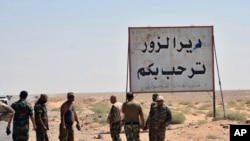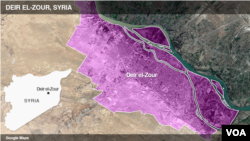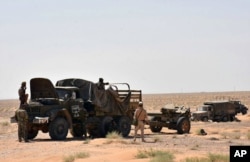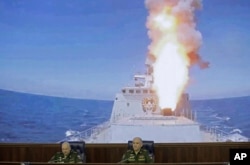The lifting of a vicious 32-month Islamic State siege of a Syrian regime enclave in Deir el-Zour city earlier this week marks a significant battlefield success for government forces. But the fight for eastern Syria is just beginning and analysts warn the toll in civilian casualties will be high.
With IS still controlling several neighborhoods in the city, and also much of the wider oil-rich province that stretches to the Iraqi border, the battle for eastern Syria is likely to prove an arduous test for the Syrian army and its allies.
That was brought home to the Syrian army by reports that one of the senior officers commanding the Deir el-Zour offensive, General Ghassan Iskendar Taraf, was badly injured Wednesday when his vehicle struck an IS land mine to the west of the city. A battle-hardened general, he commands the Al-Qassem Group, an elite force.
The U.N. estimates more than a million people are living in Deir el-Zour province. The population has been swollen by Syrians displaced from other war-torn parts of the country. U.N. officials have expressed alarm at the mounting civilian casualties in the province from the regime ground offensive as well as airstrikes conducted by Russia and the U.S.-led anti-IS coalition.
Military situation
In terms of how prolonged the fight will be for the province, the big question remains over IS determination and battlefield coherence, say analysts. In military terms, the terror group’s position in the east has been weakened substantially by the Syrian regime’s opening of the main highway into Deir el-Zour.
Analyst Aron Lund of The Century Foundation, a New York-based policy research group, dubs it “a strategic disaster for IS, which is now at its weakest since 2014 and appears unable to break out of an accelerating spiral of defeats.”
Having lifted the siege of the main regime enclave and commenced the task of retaking other IS-held neighborhoods in the city, “the Syrian government is about to flip Deir el-Zour from a costly defensive liability into an offensive asset, putting new strains on the jihadist group’s positions along the Euphrates," according to Lund. On the corresponding side of the border, Iraqi forces are preparing large-scale offensives on the jihadists, too, a squeeze that will strain what manpower IS leaders have left.
Running short of fighters
In August, IS announced a general "mobilization" of local men 20 to 30 years of age, and there have been reports of forcible enlistments of minors as well. “Even though IS recently began drafting civilians in a desperate bid to shore up its positions in eastern Syria, it is unlikely to be able to cope with the overwhelming force now bearing down on it from nearly every direction,” argues Lund.
While the conscription of locals suggests IS is running short of fighters to throw into battle, it is a tactically unpleasant way also to force locals to choose sides and to resist a regime offensive that includes Iranian-directed foreign Shi’ite militias from the east and south. U.S.-backed Kurdish-led assaults from the north are also a danger.
The enlistment ties locals to the fortunes of IS, having a son, brother or husband in the jihadists’ ranks, regardless of whether they joined willingly or not, will place families, who will already be suspect for living in an IS-controlled zone, at huge risk of retaliation and punishment from invading forces.
Syrian commanders greeted the lifting of the desperate siege earlier this week on a regime enclave sheltering about 100,000 people. “This great achievement is a strategic shift in the war on terror and confirms the ability of the Syrian Arab army and its allies,” the army command said.
Iranian, Russian forces involved
Ali Shamkhani, head of Iran’s Supreme National Security Council, said the offensive demonstrated how well Iranian, Russian and Syrian forces work together, saying the axis has “started paying dividends,” according to the Tehran Times. Analysts take that to be a pointed reference to the U.S. presence in Syria.
Iranian officials have been stressing that all "foreign" powers in the fight against IS should be mindful of Syrian sovereignty, noting that while Iranian and Russian forces were invited by Damascus into the country, U.S. forces backing the Kurds were not.
State-owned Russia Today was quick this week to highlight what the Deir el-Zour offensive means as far as Moscow sees it in the overall geopolitical game, headlining one story, “Bashar Assad's Deir ez-Zor [sic] victory puts illegal U.S. presence in spotlight.”




